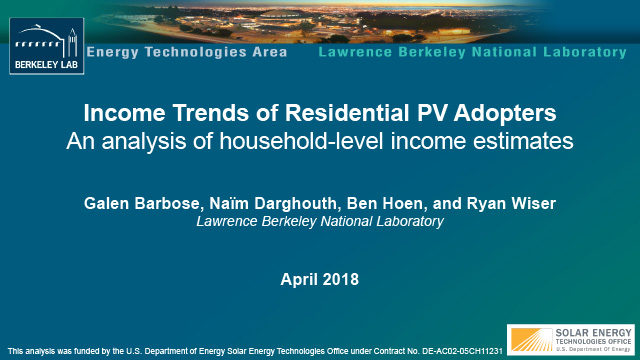Income Trends of Residential PV Adopters: An analysis of household-level income estimates
Lawrence Berkeley National Laboratory for CESA
The residential photovoltaic (PV) market has expanded rapidly over the past decade, but questions exist about how equitably that growth has occurred across income groups. Prior studies have investigated this question but are often limited by narrow geographic study regions, now-dated analysis timeframes, or coarse estimates of PV-adopter incomes. At the same time, a spate of new programs and initiatives, as well as innovations in business models and product design, have emerged in recent years with the aim of making solar more accessible and affordable to broader segments of the population. Yet, many of those efforts are proceeding without robust underlying information about the income characteristics of recent residential PV adopters.
This work aims to establish basic factual information about income trends among U.S. residential solar adopters, with some emphasis on low- and moderate-income (LMI) households. The analysis is unique in its relatively extensive coverage of the U.S. solar market, relying on Berkeley Lab’s Tracking the Sun dataset, which contains project-level data for the vast majority of all residential PV systems in the country (a subset of which are ultimately included in the analysis sample). This analysis is also unique in its use of household-level income estimates that provide a more-precise characterization of PV-adopter incomes than in most prior studies.
This report was developed for a project, led by the Clean Energy States Alliance and funded by the U.S. Department of Energy Solar Energy Technologies Office, to assist five states plus the District of Columbia to develop and implement strategies for increasing access of solar PV among LMI residents.
Associated Project(s):
Resource Details:
Date: April 2, 2018
Type: Report
Topic(s): Low- and Moderate-Income Clean Energy, Solar PV

